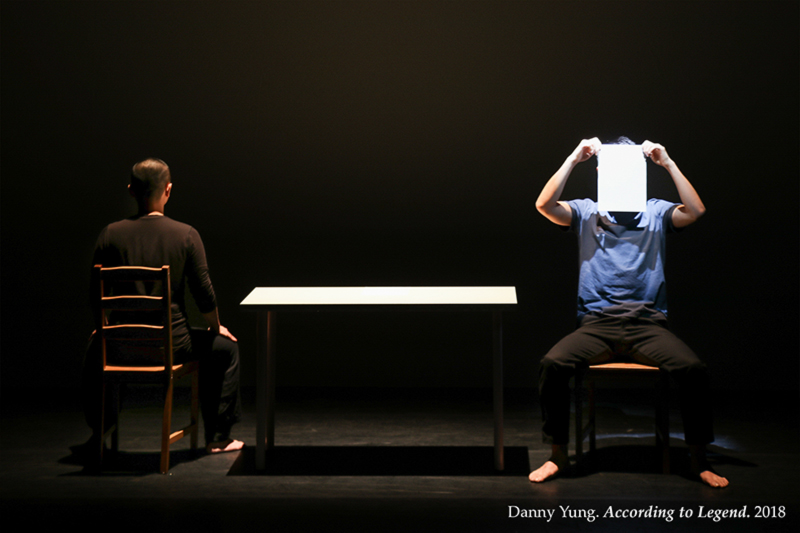
Photo Credit: Zuni Icosahedron
Background
One Table Two Chairs Creative Cultural Exchange Platform, created by Danny Yung, is inspired by the basic stage setting of traditional Chinese theatre, or xiqu, where a table and two chairs on stage render abstract ideas in the highly formulated art form. The table and two chairs on the stage of xiqu can be turned into the representational forms of different locales, indoor or outdoor; different objects from a bed to a mountain; and illustrations of various human and social relationships.
Concept
On the stage of the contemporary theatre, Yung’s concept of one table and two chairs evokes various kinds of experimentations and exchanges through the idea of crossing-over an expansive range of (digital) media, genres, cultural backgrounds, generations and regions.
Practices
Since 1990s, under Yung’s direction and curation, One Table Two Chairs Creative Cultural Exchange Platform (1T2C) has become a framework for cross-cultural dialogues, creative collaboration, and an approach to dialectical thinking. During the past decades, Yung’s O+G7ne Table Two Chairs Creative Cultural Exchange Platform has been further developed by/through different artists and creative talents all over the world, and has given birth to many creative works that drew attention of viewing and reviewing, creating and re-creating.
Programme
On 20 & 21 October 2023, with the art-tech intervention, three outstanding IT2C theatre short pieces (20 minutes each) will be presented in a triple-bill programme to be held at Studio Theatre, Nanyang Academy of Fine Arts (NAFA) in Singapore. The programme is co-presented by NAFA and Zuni Icosahedron, while Hong Kong Economic and Trade Office, Singapore is a main sponsor. NAFA is a founding member of University of the Arts Singapore. There will be a post-performance session after every performance.
Triple-bill Programme
Play 1 - Legend According to Lao Jiu
Directed by Danny Yung (Hong Kong)
Performed by Choy Yu Tin Martin (Hong Kong), Chuk Yin Man (Hong Kong)
Duration: 20 minutes
Director’s note:
To mark the anniversary of Kuo Pao Kun’s passing, Danny Yung created the theatrical piece named Legend According to Lao Jiu. The pioneer of Singapore theatre, Kuo Pao Kun was known for his classic, Lao Jiu, which is about a child in Singapore and his journey of searching and identifying himself.
Mak Yong is a traditional performing art that was banned in Malaysia. In recent years, casinos have been legalised in Singapore. Cantonese Naamyam is a traditional oral performance in Hong Kong and neighbouring areas.
Interspersing these unrelated elements, Danny Yung’s Legend According to Lao Jiu features three stories which form a dialogue with the story of Lao Jiu as a tribute to remember Kuo Pao Kun.
Play 2 - Tao of Water
Directed by Mathias Woo (Hong Kong)
Performed by Liu Chun Kin (Beijing/Hong Kong), David Yeung (Hong Kong)
Duration: 20 minutes
Adapting the AI generated voice and images of Kung Fu star Bruce Lee’s motto about water in a 20-minute theatre experience, Mathias explained, “‘Best to be like water’ talks about the infiltrability of water. Western thinking is about the comparison of absoluteness, but the Tao Te Ching is about the comparison of relativeness.”
“The performance fuses existing stage technical setup and new art-tech development of gaming software and hardware for experimentation to present “relativeness”. It incorporates various sounds and forms of water. Many logics in the Tao Te Ching can be the ways that guide our thoughts and behaviours. Beauty coexists with ugliness, expensiveness coexists with non-expensiveness. I think this is very special.” Mathias explained.
Play 3 - School of Thought
Directed by Liu Xiaoyi (Singapore)
Performed by Didik Nini Thowok (Yogyakarta), Makoto Matsushima (Tokyo)
Duration: 20 minutes
Director’s note:
School of Thought represents Liu Xiaoyi’s reflections upon the realm of artistic education. Over the span of the past two decades, Liu Xiaoyi, through the exploration of artistic education, has ceaselessly pondered the interplay between creativity and education. This work stands as an exercise stemming from these contemplations.
Liu Xiaoyi has enlisted the collaboration of two seasoned performing artists, Didik and Matsushima, to jointly delve into the annals of the history of body training and the evolution of the stage. Through this lens, they embark on a discourse that extrapolates upon the prospective trajectory and evolution of Asian art education. The corporeal embodiments of contemporary dance and Javanese dance draw nigh on the stage, akin to phantasms, then recede; they brush against each other, yet hesitantly recoil from full contact… Their actions appear to reflect upon their own training history, while also casting their gaze toward the future of Asian cultural exchanges.